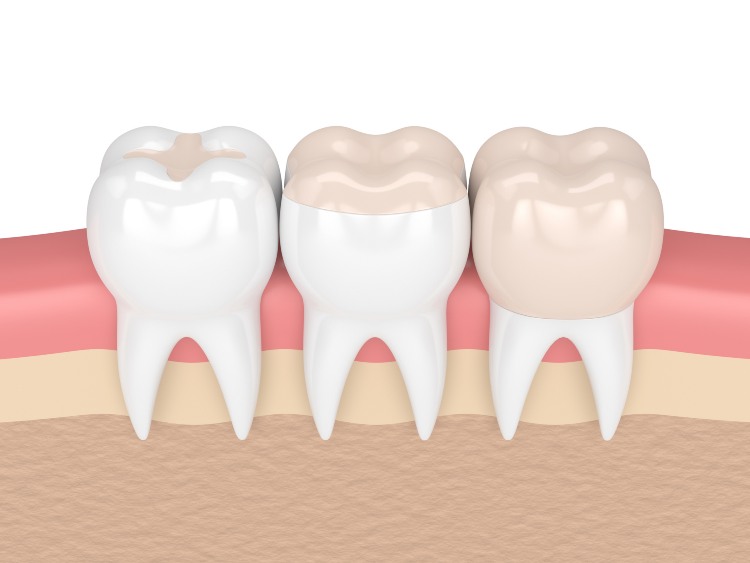Inlays & Onlays Procedure in Scottsdale, AZ
What Are Dental Inlays and Onlays?
Dental inlays and onlays are custom-made restorations used to repair damaged or decayed teeth. While both serve similar purposes, their key difference lies in their placement:
- Inlays – Cover the pits and fissures of a tooth, fitting neatly within the grooves on the chewing surface. An inlay fits perfectly into the hollow part of the tooth, restoring its chewing surface without covering the cusps (the raised points).
- Onlays – Onlays, on the other hand, extends over one or more cusps of the tooth. They are often referred to as “partial crowns” because they cover a larger area than inlays but are not as extensive as full dental crowns.

Inlay vs. Onlay
We perform an inlay procedure when only a part of your tooth is damaged or broken. We’ll pre-mold the inlay to fit perfectly into the grooves of your teeth, matching the color of the surrounding teeth. A dental onlay procedure is often performed when a traditional filling cannot repair the area. We commonly use onlays on the biting surface or cusp of teeth. We offer onlays and inlays made with porcelain for a durable, strong fit, or traditional composite resin. The material is not as visible on the back molars, but most patients choose attractive porcelain for a front tooth onlay’s natural appearance.
Inlays and Onlays vs. Other Dental Treatments
Inlays and onlays are similar to dental crowns, fillings, and veneers because they address many of the same dental issues. The differences between inlays and onlays and other dental treatments include:
- Veneers and inlays can both cover the front and sides of teeth. Porcelain veneers are built to boost the appearance without the structural support of an inlay.
- A filling fills empty space following the removal of a cavity, while an inlay provides superior structural support to the tooth.
- An onlay is used when the damage to a tooth is not severe enough for a crown. A crown is both functional and cosmetic, covering and reshaping the entire tooth.

Inlay and Onlay Materials
We provide inlays and onlays made from a range of materials tailored to your smile. Different materials offer unique advantages, and each material will react differently to wear and temperature changes, influencing factors like sensitivity and longevity. Your selection of material involves careful consideration of both functional and cosmetic factors, ensuring you receive restorations that blend seamlessly with your dental health and smile. Here are some of our offerings to consider:
- Ceramic – Known for its durability and ability to match the color of natural teeth, ceramic is a popular choice for visible teeth.
- Porcelain – Porcelain offers a natural look and is resistant to staining, making it ideal for long-lasting aesthetic results.
- Composite Resin – This material can be color-matched to your teeth and is easier to apply, but it may not be as durable as ceramic or porcelain.
- Gold – Although less common today due to its conspicuous appearance, gold remains an excellent choice for its durability and biocompatibility.
Applying Inlays and Onlays
Inlays and onlays are applied at two different dental visits. At the first visit, we’ll remove or replace the damaged area of your tooth to prepare for the inlay or onlay. We’ll take an impression of your tooth and apply a temporary sealant. We’ll remove the temporary dental sealant at the second visit and apply the customized inlay or onlay to your tooth. Here’s a step-by-step of what you can expect:
- Step 1: Initial Examination and Preparation – We will begin with an oral examination to assess the extent of damage to your tooth. After confirming that an inlay or onlay is the best option, they will remove the damaged portion of the tooth, ensuring the remaining structure is clean and healthy.
- Step 2: Taking an Impression – Next, an impression of your tooth will be taken and sent to a dental lab, where your custom inlay or onlay will be crafted. This ensures a perfect fit and optimal function.
- Step 3: Temporary Restoration – While waiting for your permanent restoration, a temporary inlay or onlay will be put in place to protect your tooth.
- Step 4: Final Placement – Once your custom inlay or onlay is ready, you’ll return to the clinic to have it fitted. We will ensure it fits perfectly and then bond it to your tooth using a strong dental adhesive.
- Step 5: Aftercare – We will provide aftercare instructions, which may include avoiding certain foods and practicing good oral hygiene to ensure the longevity of your restoration.
Are Dental Inlays and Onlays Painful?
One of the most common questions we hear is, “Are dental inlays and onlays painful?” The answer is generally no. During the procedure, local anesthesia is used to numb the area, minimizing discomfort. After the anesthesia wears off, you might experience some sensitivity and mild discomfort, especially if an onlay was used. This is completely normal and should subside within a few days.
Our Conservative Approach
At S&C Dental, we want to do what’s best for your teeth. We choose the most conservative approach to ensure your comfort and oral health come first. We try to preserve as much of your natural tooth as possible while repairing the issue. We understand putting a large filling in your tooth will weaken its structure, leading to a possible future root canal. Dental crowns require removing a large portion of your natural tooth, leading to potential future damage. Inlays and onlays allow us only to remove damaged portions of your teeth, helping to save the natural tooth.
Contact S&C Dental For Inlays and Onlays
If you’ve been considering a tooth transformation, inlays and onlays might be the perfect solution. We know decayed, damaged, and broken teeth can be challenging problems. The good news is that inlays and onlays provide an aesthetically-pleasing, durable way to solve many dental issues. We’ll look at your dental issues and help you decide if an inlay or onlay is the best fit for your needs. To schedule an appointment, contact us today.

